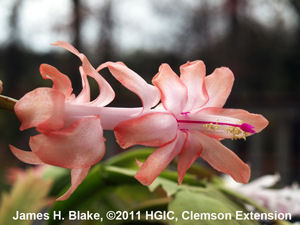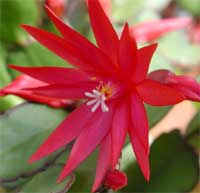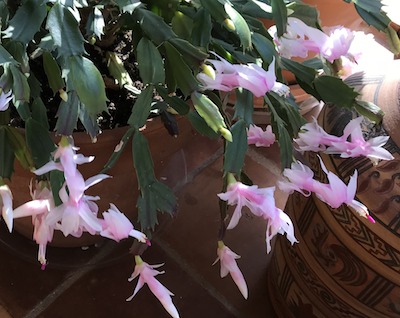Holiday Cacti Brighten the Seasons
By Gretchen Spencer, Fairfax Master Gardener

Thanksgiving cactus with peach-colored blossoms
Every year, my “Christmas” cactus, a Christmas gift I received several years ago, blooms at Thanksgiving. I just assumed it was an early bloomer or a precocious plant that couldn’t wait to show off its blossoms. I never wondered why it flowered before Christmas. I just admired its profusion of pale pink flowers that gradually opened at the ends of its gracefully arching stems. Now, after researching holiday cacti for this article, I discovered that I really have a Thanksgiving cactus that does, indeed, bloom at Thanksgiving. In fact, there are three different holiday cacti, whose common names indicate their relative blooming time: they are the Thanksgiving cactus (Schlumbergera truncata), the Christmas cactus (Schlumbergera bridgesii), and the Easter cactus (Rhipsalidopsis gaertneri).

Easter cactus (Rhipsalidopsis gaertneri)
Distinguishing Holiday Cacti
Besides blooming at different times, one can distinguish between these three cacti by the shape of their “leaves,” which are actually flattened stem segments called phylloclades. The Thanksgiving cactus has two to four pointed saw-toothed projections on the margins of its leaves. Another common name for this plant is the crab cactus. The Christmas cactus’s leaf projections are more rounded or tear-drop shaped. The leaves of the Easter cactus have scalloped edges. Another way to distinguish between the Thanksgiving and Christmas cacti is to look at the color of the anthers. The Thanksgiving cactus has yellow anthers, and the Christmas cactus has anthers that are purplish brown. Sure enough, the anthers on my cactus are yellow.

Thanksgiving cactus with pink blossoms
Growing and Propagating Holiday Cacti
Holiday cacti are relatively easy to grow and long-lived. Some plants are known to have lived over 100 years. While holiday cacti are true cacti, they are not desert plants but rain forest plants, native to Brazil. They are also epiphytes like orchids, bromeliads and mosses. Epiphytes grow on other plants and obtain moisture and nutrients from the air, rain and decaying matter in their immediate environment.
Since these plants are tropical cacti, they prefer bright indoor light — though full sunlight in the fall and winter is beneficial — light shade outdoors in the summer and soil high in organic matter. My Thanksgiving cactus is thriving in a southern window where it receives direct sunlight this time of year. However, I am careful not to move it, as these cacti are sensitive to changes in light and temperature. Moving them can cause the buds to drop off, as can drafts and extreme changes in temperature. These cacti also prefer to be somewhat pot-bound as that encourages flowering. Good drainage and watering when the soil is dry to one inch below the surface are two requirements. Never let water sit in the saucer.

Christmas cactus (schlumbergera-bridgesii-cladophyll)
A holiday cactus in bloom with its “exotic” flowers is lovely to behold. There are holiday cacti available in a range of colors that include red, rose, lavender, peach, purple, orange, cream and white. It’s important to know that these plants are “short-day” plants. The Thanksgiving and Christmas cacti require short days of eight to ten hours, and at least 12 hours of uninterrupted darkness and cooler night temperatures for about six weeks to bloom. Fall growing temperatures should be between 60 and 68 degrees F during the day and 55 to 65 degrees F at night to encourage maximum flowering. The Easter cactus requires eight to 12 weeks of short days to encourage blooming.
Holiday cacti’s growing season is from April to September. During these months it can be placed outside in light shade or a semi-shady area and fertilized in June through August with a balanced houseplant fertilizer at half strength. After flowering, plants can be pruned to encourage more branching. Also, new plants can be grown from cuttings that are dipped in water and a rooting hormone and placed in builder’s sand or a light potting soil that drains well. Once roots have formed, plant the cuttings in cactus soil. One recipe for holiday cactus soil is one part sterile potting soil, two parts peat moss and one part sharp builder’s sand or perlite.
While it may seem that the Thanksgiving and Christmas cacti are fussy plants and have exacting requirements to induce blooming, I do little to mine and it blooms happily. I am careful to water it only when it is dry and to keep it in the same place. It lives in front of a large picture window in a room that we don’t use very often at night, so it experiences short days and long nights as the seasons progress. And to conserve energy, our house is quite cool at night. These holiday cacti are really easy to grow, and their delightful blossoms brighten up the holiday season.
Resources
• Care of Specialty Potted Plants, VCE Publication 426-101
• Holiday cacti: Christmas cactus, Thanksgiving cactus, and Easter cactus, University of Minnesota
Extension
• Thanksgiving & Christmas Cacti, HGIC 1554, Clemson Cooperative Extension
• Is it a Thanksgiving, Christmas or Easter Cactus?, Iowa State University Extension and Outreach
…edited 2020